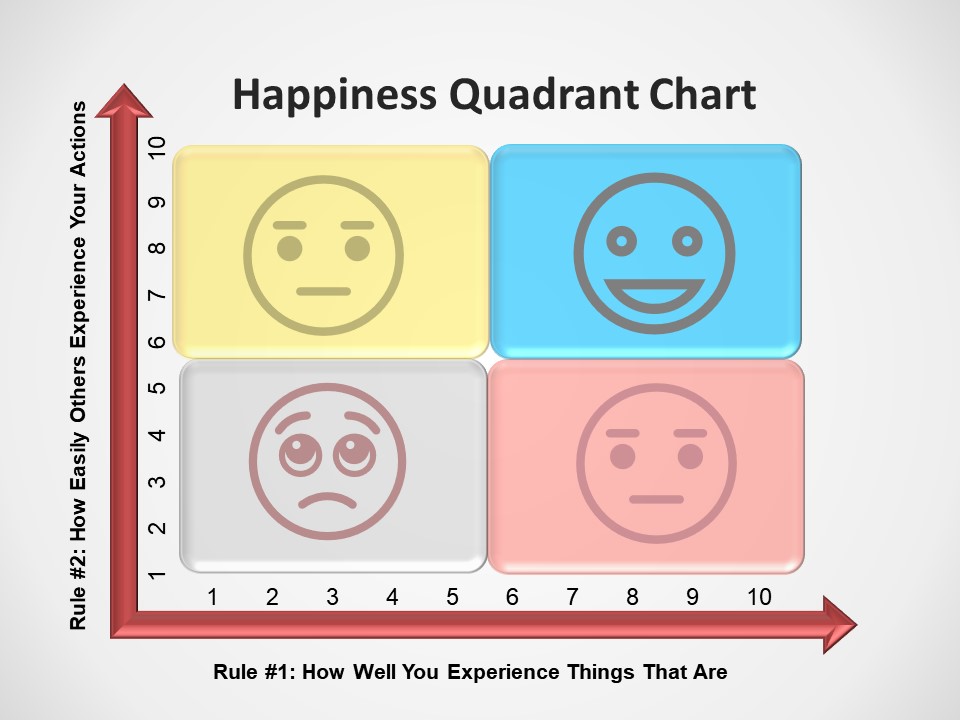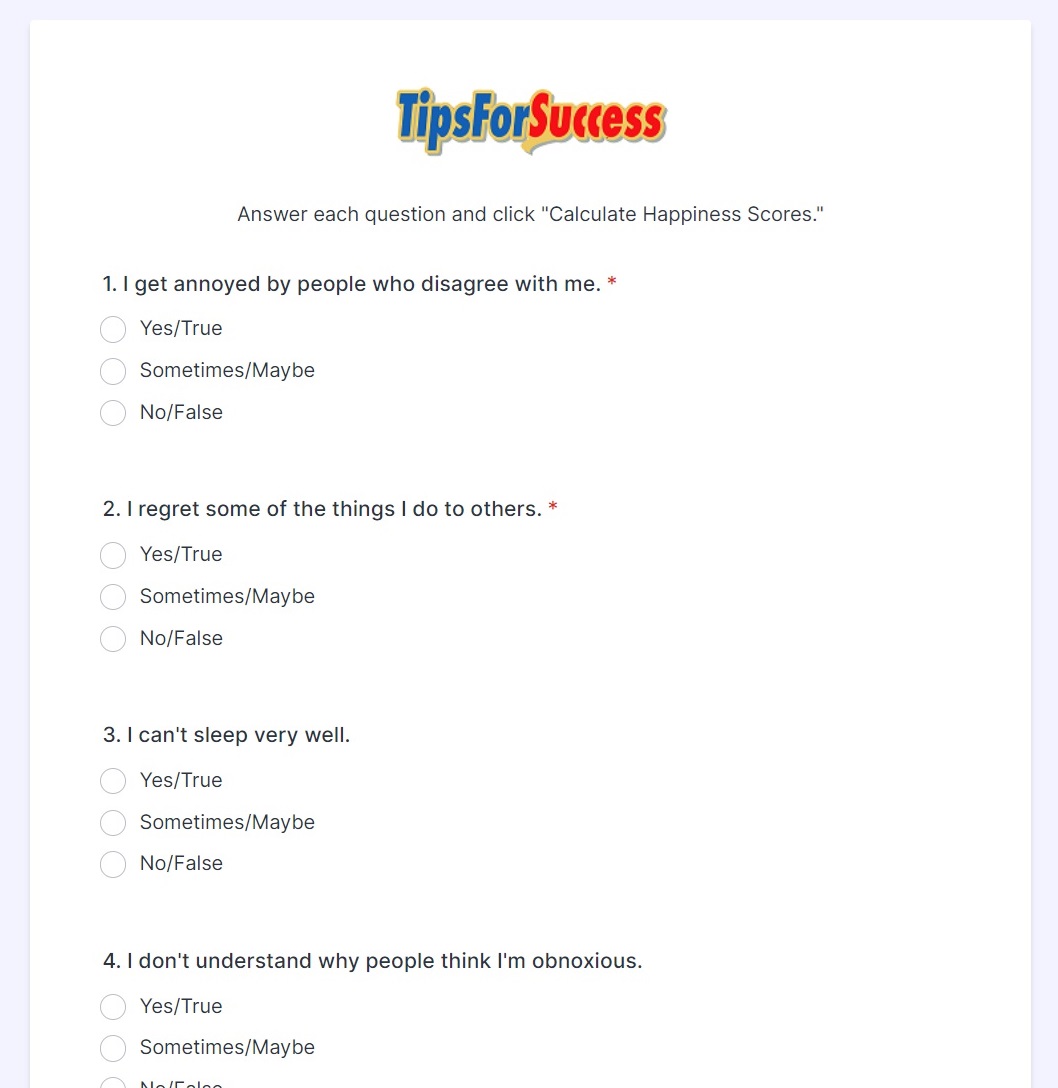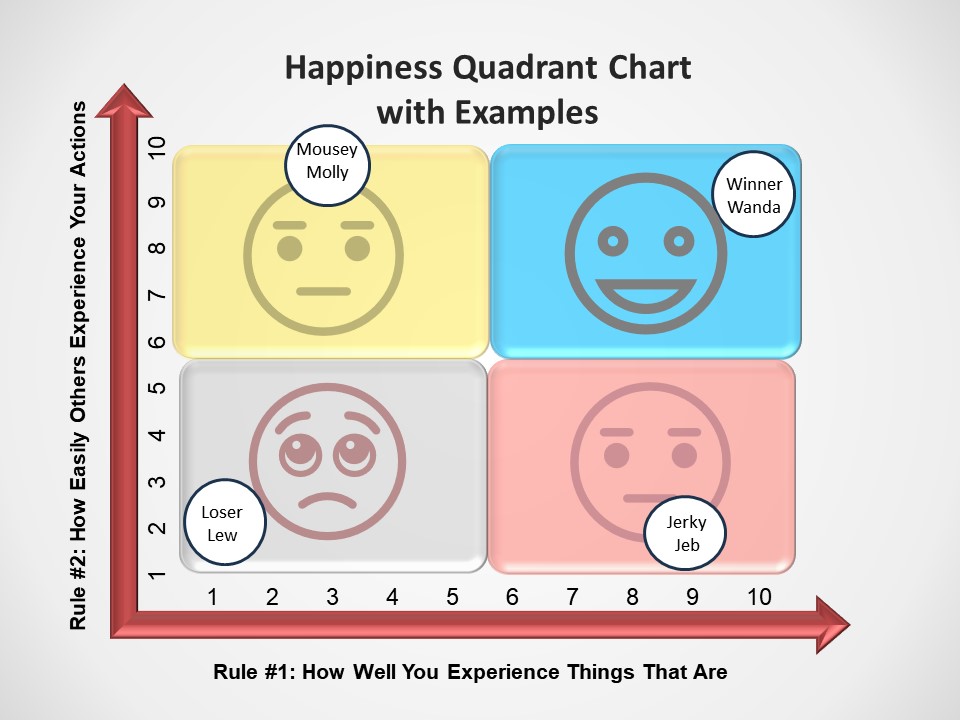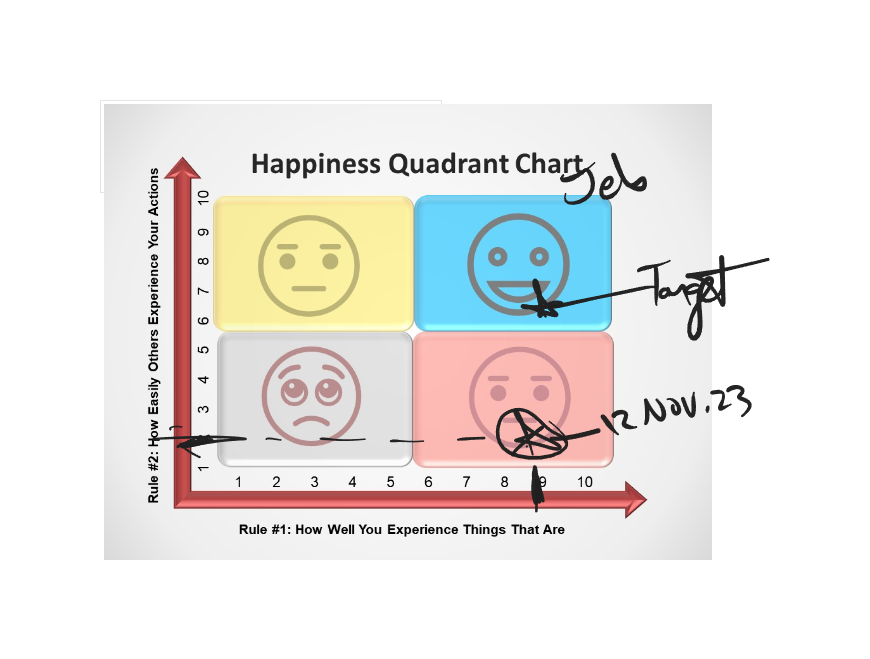The Happiness Quadrant Chart
 Is it possible for you to have a happy day? All day? Every day?
Is it possible for you to have a happy day? All day? Every day?
Many people doubt it. They say,
- “Anyone who tells you they’re happy is lying.”
- “I’d only be happy if I had a better _____ (spouse, job, body, parent, child, boss, partner, government).”
- “Life sucks and then you die.”
The truth is, you are the one who controls the amount of joy you have in your life. You control it based on how well you follow “The Two Rules for Happy Living” which are:
“One: Be able to experience anything.
“Two: Cause only those things which others are able to experience easily.” — L. Ron Hubbard
Any time you are unhappy, you are breaking one of these rules.
Rule One
When you cannot experience something, you are unhappy because you cannot “be there” with it. You cannot face it. It makes you uncomfortable or worse.
For example, you are unhappy when someone yells at you. You cannot stand it. It ruins your day.
So you decide to find out a way to comfortably experience being yelled at. You have a friend yell at you over and over. After he does this a dozen times, you say, “Oh! It’s just noise. I can handle this.” You no longer resist it. Because you can now experience people yelling at you, it no longer makes you unhappy.
“To be happy, one only must be able to confront, which is to say, experience those things that are.” — L. Ron Hubbard
Rule Two
“Two: Cause only those things which others are able to experience easily.” — L. Ron Hubbard
This means you need to pay attention to people’s reactions as everyone experiences things differently. Here are three examples:
- Your colorful language offends your mother, but makes your friend laugh. So you avoid your special words around your mom.
- Spending the day at a shopping mall is a joy for your daughter, but a boring waste of time for your son. So you find activities that everyone can easily experience.
- Your political views enrage your father-in-law, but inspire your neighbor. So you do not talk about politics around your father-in-law.
If you don’t care about other people’s happiness, the people around you will not care about your happiness.
“To create only those effects which others could easily experience gives us a clean new rule of living.” — L. Ron Hubbard
How to Use The Happiness Quadrant Chart
This chart shows how well you follow the two happiness rules. The closer you are to the top right corner, the happier you are.
As you can see, the chart has four squares or “quadrants.” Your position on the chart is based on your Rule #1 score (along the bottom) and your Rule #2 score (along the left side).
- If you are in the top right quadrant, you lead a happy life. You are at the top of the Emotional Tone Scale.
- If you are in the bottom right or top left quadrants, you are happy at times and unhappy at times. You are in the middle of the Tone Scale.
- If you are in the bottom left quadrant, you lead an unhappy life. You are in the lower part of the Tone Scale.

How to calculate your scores for the two rules:
- Print a Happiness Quadrant Chart (or open it with an image editor) so can mark your scores and position.
- Answer the “Happiness Chart Calculator” to get your two scores.
- Mark your Rule #1 score on the bottom of your chart and Rule #2 score on the left side of the chart.
- Mark or “plot” your position where the two scores intersect. See the four examples below.
- Follow the “Action Plan Recommendations” below to become happier than ever before.
Four Examples
1. Lew the Loser
Lew is an Uber driver who pretends to be polite to his customers, at first, but always finds a disagreement. “I don’t care which route you want to take.” “Well, you should have been ready sooner.” “I will only follow Google Maps.” Lew thinks, “Uber pay is so bad, I don’t need to be nice.” Lew scores a 2 on the left side of the quadrant.
Lew loves to get drunk. “It’s the only part of life I like.” He neglects his health and wastes his money on bad food and booze. Eventually, he stops working, gets evicted from his apartment and lives in his car. Lew scores a 1 along the bottom because he cannot experience life.
Because Lew breaks both rules for happy living, he suffers. His life is miserable.
On the “Happiness Chart with Examples” image, you can see Lew in the bottom left corner.
2. Molly the Mouse
All her life, Molly has been extremely nice to people. She is so afraid of offending anyone, she automatically apologizes to be on the safe side.
“Oh, sorry, excuse me, but the line for the movie starts back there, but go ahead and get in front of me.”
“You want my paycheck as a loan? OK, here you go. I’ll use my savings for bills.”
Anything she does can be experienced easily by everyone, so she gets a 10 on the left side of the quadrant.
Of course, Molly is terrified people. She cannot experience any bad reactions from them. She cannot handle disagreements and lets people control her opinions and activities. If someone tries to sell her something, she tries to give them the money “to be nice.”
Because she cannot experience much in life, Molly scores a 3 on the bottom. Molly is unhappy.
You can see Molly on the Happiness Chart near the top left corner.
3. Jeb the Jerk
Jeb is a college football player who is afraid of nothing. He blocks or tackles big powerful men with no fear of painful injuries. He also has no problem with his education and life responsibilities. Everyone, especially Jeb, believes he’ll be a huge success in life. He scores a 9 on the bottom line because he’s willing to experience almost anything. He’s a winner!
Unfortunately, he is also a rude jerk.
He says to his teammates. “You guys are losers because you’re afraid of a little pain.”
Women are willing to meet with him, but he soon offends them. “Oh, c’mon. Can’t you take a little joke? Fine, your loss.”
Jeb is famous for causing experiences people cannot easily experience, so gets a score of 2 on the left side. He is unhappy.
Jeb is on the bottom right of the Happiness Chart.
4. Wanda the Winner
Despite being a single mom with two jobs, Wanda’s mom taught her how to accept life just as it is. She learned to be comfortable in a cold, noisy apartment surrounded by sketchy people. Starting at age 12, she learned to experience cleaning jobs and never complain.
As a result, Wanda put herself through college and earned her teaching degree at the head of her class. Because Wanda calmly experiences everything, she scores a 10 along the bottom line.
As a school teacher, her students love her. They happily follow her instructions as she makes them feel safe and important. Wanda also enjoys a popular social life because her friends know they can trust her with their deepest secrets. Being with Wanda is a great experience so she scores a 10 on the left side.
Wanda is very happy with her life.
See Wanda’s position on the Happiness Chart near to the top right corner.
Where are you on this chart? What is your score?
Action Plan Recommendations
To help you create your plan, and mark your position on the Happiness Quadrant Chart, as explained above.
- Start with Rule #1. Write down everything that is hard for you to experience.
- Next to each one, write how you can experience it more easily. You have at least ten choices:
- Handle it
- Accept it
- Change it
- Get used to it
- Take responsibility for it
- Admire it
- Improve it
- Control it (see Control Parts 1-6)
- Lighten up about it
- Join it
- Work on Rule #2. List what you do that others may not experience easily.
- Next to each one, write how you can change so others can easily experience their time with you. You have at least ten options:
- Whenever you feel angry or want to attack someone, take ten breaths, calm down and act rationally.
- Focus on your objectives, not a person who gets in your way.
- Find out by asking the person. “Would you mind if I leave early?” “Does it bother you when I’m strict about these company policies?”
- Warn them. “I have some good news and some bad news. What do you want to hear first?” “I have some advice, but you might not like hearing it. Want me to wait?”
- Be tolerant of people who cannot face life very well. Try to help them, one tiny step at a time. “You can wait to fix your car. How about walking? It’ll only take 15 minutes.”
- Make more jokes about yourself. “I think Joe’s mistakes are hilarious, but he’ll never reach my level of goofs. I’m the king of stupid mistakes.”
- Improve your manners or use more kindness.
- Apologize whenever you cause harm.
- If you must evaluate someone, give more positives than negatives. Be more complimentary than critical. Pass out more sugar than spice.
- You now have two lists of actions you can take to be happier. Write down your happiness plan and get busy!
Your life will become happier than you can imagine.
From time to time, repeat these steps and mark your position on the Happiness Quadrant. Continue until you reach the top right corner and stay there.
More Information
Enjoy this audio recording of L. Ron Hubbard, “Is it Possible to Be Happy?“
Read the “The Two Rules for Happy Living” in A New Slant on Life

